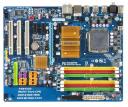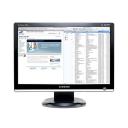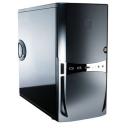Welcome to the third ever “If I were to buy a new computer today” feature. I was going to wait until March to write this new installment (as to keep it a tri-monthly feature), but there has been some interesting developments recently that I wanted to write about (plus I don’t have anything else to write about). You can read the last instalment here.
Back in September, I first wrote about what I would be looking for in a computer if I were buying one today, and today’s blog will see what has changed in the last few month. To get a better idea of the kind of system I’m looking for, please refer to the original blog entry, but to sum up, it would be a system for playing the latest 3D games as well as a system ready for Blu-ray and HD DVD playback, but one that is reasonable in price and without the need for overclocking.
So let’s not waste any time. Here are the specs of the computer, including comparisons with the last specs from December (as compared to December: upgraded parts in blue, lower prices in green, higher prices in red):
| Type: | December Part: | February Part: | December Price ($AUD): |
February Price ($AUD): |
| CPU: | Intel Core2Duo 6750 | Intel Core2Duo 8400 | $227 | $264 |
| Motherboard: | Gigabyte GA-P35C-DS3R (Rev 2.0) | Gigabyte GA-P35C-DS3R (Rev 2.0) | $165 | $156 |
| RAM: | Corsair 2 GB PC-8500 C5D | Corsair 2 GB PC-8500 C5D | $244 | $213 |
| HDD: | 2 x Seagate 400GB 7200RPM 16MB SATA2 | 2 x Seagate 500GB 7200RPM 32MB SATA2 | $238 | $312 |
| Video Card: | NVIDIA GeForce 8800 GT 512 MB (XFX) | NVIDIA GeForce 8800 GT 512 MB (XFX) | $389 | $365 |
| Sound Card: | In-Built | In-Built | N/A | N/A |
| Optical Drive: | LG GGC-H20L (Blu-ray/HD DVD Reader, DVD writer) |
Pioneer BCD-S02 | $460 | $215 |
| Monitor: | Chimei 22″ 221D | Samsung 22″ 226BW | $309 | $397 |
| Case: | Antenc Sonata III | Antenc Sonata III | $179 | $178 |
| Total Price ($AUD): | $2,211 | $2,100 | ||
The price of the system has dropped $111, but the specification of the system has also been improved, now with a state of the art Intel Penryn 45nm CPU, a set of bigger hard-drives and a superior Samsung LCD monitor. Let’s go over each specification.
CPU: I’ve changed the spec from an Intel Core2Duo 6750 to the new 8400 part. The 8400 is Penryn chip based on the new 45nm process, which means lower power usage and a cooler CPU. Reviews of this new chip has been extremely positive, with clear improvements over the 6750. The real improvement will come later in the year when a new architecture is unveiled to take full advantage of the new 45nm process. AMD has also released their new Phenom range of CPUs, and the 9500 is an attractive package at just slightly cheaper than the 8400, although not as efficient considering it is still a 65nm part. Obviously, choosing a Phenom means a different motherboard choice to the one I’ve listed, but the price should remain similar.
 Motherboard: I’ve stuck with my choice of motherboard from the last update. I like Gigabyte motherboards, although the sheer number of models that are available for a single chipset is a big confusing at times. Gigabyte was recently chosen as the best overall motherboard manufacturer in an Australian PC magazine survey (PC Authority). The model I chose is one that supports both DDR2 and DDR3 memory, allowing for a smoother upgrade path when DDR3 memory pricing becomes a bit more reasonable. Despite getting a newer motherboard, the price has actually decreased. Note that the previous chosen motherboard had ATI crossfire support, which the new one does not, but since we’re going with an NVIDIA card anyway, it doesn’t really matter.
Motherboard: I’ve stuck with my choice of motherboard from the last update. I like Gigabyte motherboards, although the sheer number of models that are available for a single chipset is a big confusing at times. Gigabyte was recently chosen as the best overall motherboard manufacturer in an Australian PC magazine survey (PC Authority). The model I chose is one that supports both DDR2 and DDR3 memory, allowing for a smoother upgrade path when DDR3 memory pricing becomes a bit more reasonable. Despite getting a newer motherboard, the price has actually decreased. Note that the previous chosen motherboard had ATI crossfire support, which the new one does not, but since we’re going with an NVIDIA card anyway, it doesn’t really matter.
RAM: We’re sticking with our choice from last time again. DDR3 memory is still not cheap enough for us to consider, but our choice of motherboard above means we can use DDR2 for now, and upgrade to DDR3 when they become more reasonable in pricing.
HDD: This is where the increased costs mainly comes from. An upgrade from 400 GB (which seems to be no longer available) to 500 GB, and the 32MB version as well. Still sticking with a Seagate drive. The same PC Authority survey I mentioned above also gave Seagate the best overall award, so it’s an easy choice for me.
 Video Card: I had to think about either sticking with the 8800 GT 512 MB, or getting the new 8800 GTS 512 MB (don’t get the 320 or 640 MB version, since they are old models while sharing the same 8800 GTS name). Because the price has already went up more than $100 for the updated specs, I decided to hold off and keep the 8800 GT for now. If an extra $110 is not a big deal, then get the 8800 GTS 512MB.
Video Card: I had to think about either sticking with the 8800 GT 512 MB, or getting the new 8800 GTS 512 MB (don’t get the 320 or 640 MB version, since they are old models while sharing the same 8800 GTS name). Because the price has already went up more than $100 for the updated specs, I decided to hold off and keep the 8800 GT for now. If an extra $110 is not a big deal, then get the 8800 GTS 512MB.
Sound Card: Still going with a on-board solution. Until HDMI audio output gets sorted out, it’s probably not worth getting a new sound-card for your PC. HDMI audio output would allow the pass-thru or decoding or several of the new HD audio formats, which is not possible through SPDIF/optical due to insufficient bandwidth.
 Optical Drive: Still sticking with the state-of-the-art Blu-ray and HD DVD dual format reader drive, which also can write to the usual DVD formats. With this drive, you can make your PC format neutral and playback both Blu-ray and HD DVD movies. The huge cost increase, especially for those that want HD movie playback right now, is therefore understandable. If you want to save a bit of money, you can get the Pioneer BDC-S02 Blu-ray reader and CD/DVD writer drive for $215, but you miss out on the ability to play HD DVD movies, which still make up nearly 50% of all available HD movies. Update: With the high definition format war appearing to be over and Blu-ray the victor, I have updated the specs to use the Pioneer BDC-S02 drive, instead of the LG dual format drive. Those with HD DVD movies and want to play them on the computer might still consider the LG drive better value. The Pioneer is exactly half price of the LG, so the extra savings means that this instalment’s computer is actually cheaper than last instalment’s.
Optical Drive: Still sticking with the state-of-the-art Blu-ray and HD DVD dual format reader drive, which also can write to the usual DVD formats. With this drive, you can make your PC format neutral and playback both Blu-ray and HD DVD movies. The huge cost increase, especially for those that want HD movie playback right now, is therefore understandable. If you want to save a bit of money, you can get the Pioneer BDC-S02 Blu-ray reader and CD/DVD writer drive for $215, but you miss out on the ability to play HD DVD movies, which still make up nearly 50% of all available HD movies. Update: With the high definition format war appearing to be over and Blu-ray the victor, I have updated the specs to use the Pioneer BDC-S02 drive, instead of the LG dual format drive. Those with HD DVD movies and want to play them on the computer might still consider the LG drive better value. The Pioneer is exactly half price of the LG, so the extra savings means that this instalment’s computer is actually cheaper than last instalment’s.
 Monitor: I’ve chosen the Chimei 22″ for a while now, so I thought it might be time to upgrade. The new monitor I’ve chosen is the Samsung 226BW 22″ model, which looks a lot nicer than the Chimei, both in terms of style and picture quality. The monitor has a resolution of 1680×1050, which is still a bit lacking for 1080p HD content, but you will need to up the size to 24″ to be able to buy a monitor that is capable of 1080p display (like the Samsung 24″ 245B), which means at least another extra $200. Others might want to consider a HDMI capable monitor (the Chimei has a HDMI capable model), but it’s not needed for Blu-ray/HD DVD playback as long as the DVI port is HDCP compatible (which it is) – the 8800 GT doesn’t even have HDMI output anyway. The main use for HDMI would be to connect external devices to the monitor (eg. the PS3), but 22″ is probably on the small side if you plan on using the monitor for watching Blu-ray/HD DVD.
Monitor: I’ve chosen the Chimei 22″ for a while now, so I thought it might be time to upgrade. The new monitor I’ve chosen is the Samsung 226BW 22″ model, which looks a lot nicer than the Chimei, both in terms of style and picture quality. The monitor has a resolution of 1680×1050, which is still a bit lacking for 1080p HD content, but you will need to up the size to 24″ to be able to buy a monitor that is capable of 1080p display (like the Samsung 24″ 245B), which means at least another extra $200. Others might want to consider a HDMI capable monitor (the Chimei has a HDMI capable model), but it’s not needed for Blu-ray/HD DVD playback as long as the DVI port is HDCP compatible (which it is) – the 8800 GT doesn’t even have HDMI output anyway. The main use for HDMI would be to connect external devices to the monitor (eg. the PS3), but 22″ is probably on the small side if you plan on using the monitor for watching Blu-ray/HD DVD.
 Case: Again, I’m sticking with the Antec Sonata III case, because it’s good value as it comes with a high quality 500W power supply (designed for quietness), and the overall build quality of the case (and Antec cases, in general) is quite good. Building a quiet system is essential if you plan on using the machine as your Blu-ray/HD DVD player. Of course, a quiet PC depends much on the type of cooling you have for your CPU and GPU.
Case: Again, I’m sticking with the Antec Sonata III case, because it’s good value as it comes with a high quality 500W power supply (designed for quietness), and the overall build quality of the case (and Antec cases, in general) is quite good. Building a quiet system is essential if you plan on using the machine as your Blu-ray/HD DVD player. Of course, a quiet PC depends much on the type of cooling you have for your CPU and GPU.
While $AUD 2,100 (that’s $1,930 for you US folk) is a bit on the high end, we are loading the system with some very new and higher quality parts. This is a system that will pretty much do everything and then some. Whether it’s gaming or HD, it won’t disappoint. Hopefully by our next instalment, DDR3 prices will have dropped, and perhaps a new graphics card will tempt us to upgrade the specs again. So until then …

